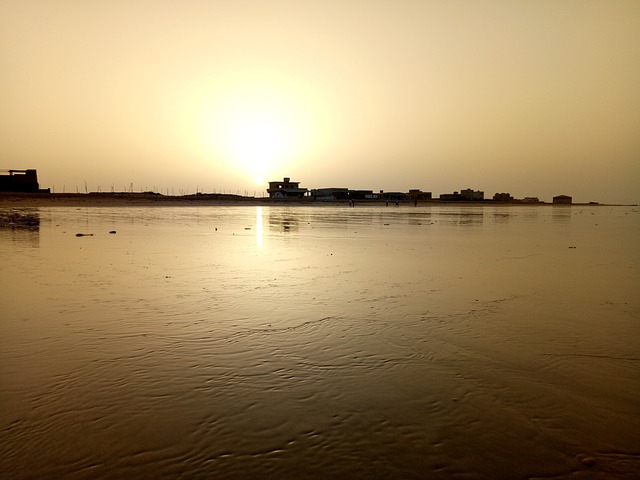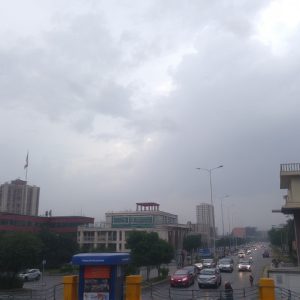Karachi’s Rain Outlook: Preparedness and Patterns
Pakistan's Meteorological Department forecasts a week of rainy weather for Karachi, with poten…….

Pakistan's Meteorological Department forecasts a week of rainy weather for Karachi, with potential for scattered rain showers, thunderstorms, and increased humidity. These rains are expected to ease the summer heat but could lead to localized flooding due to the city's strained drainage systems, exacerbated by its rapid urban growth, climate change, and aging infrastructure. The risk of disruptions to air and maritime travel due to poor visibility and strong winds is also high. Authorities are preparing for the increased water flow and clearing drains to mitigate flooding. Residents are being advised to heed weather warnings, clear clogged drainage systems, secure loose items, stock essential supplies, and have an emergency plan in place. Officials are actively monitoring the situation and updating residents to ensure their safety during the anticipated heavy rains.
As Karachi braces for anticipated rainfall this week, a keen understanding of local weather patterns, urban drainage systems, and potential flood risks is paramount. This article delves into the expected precipitation trends, scrutinizing how these patterns may unfold. It also addresses the daunting challenges faced by Karachi’s urban drainage infrastructure, highlighting areas most susceptible to flooding. In light of these insights, the focus shifts to the crucial preparation and emergency measures residents must undertake to mitigate risks. Additionally, the article explores the evolution and reliability of weather forecasts, ensuring a comprehensive approach to this week’s expected rain in Karachi. With these key insights, the city stands better prepared to face the wettest days ahead.
- Anticipated Precipitation Patterns
- Urban Drainage Challenges
- Potential Flooding Areas in Karachi
- Preparation and Emergency Measures for Residents
Anticipated Precipitation Patterns

Recent meteorological data indicates a likelihood of precipitation in Karachi over the forthcoming week. The anticipated rainfall pattern suggests a gradual increase in humidity levels, which is typical for this time of year in the region. The Pakistan Meteorological Department has forecasted scattered rain showers with isolated thunderstorms, particularly over the coastal districts including Karachi. These weather events are expected to bring relief from the sweltering heat that has prevailed throughout the summer months.
The precipitation is predicted to be moderate to heavy in intensity at times, with the potential for localized flooding in low-lying areas due to the city’s drainage capacity being stretched by the intense monsoon rains. The weather bureau also notes that the rainfall could affect flight operations and cause disruptions in road and maritime traffic due to poor visibility and strong winds. Residents are advised to stay updated on weather advisories and take necessary precautions to safeguard life and property. With these patterns in mind, it is crucial for local authorities to prepare for the expected increase in water flow in drains and river channels to minimize the impact of any flooding incidents.
Urban Drainage Challenges

Urban drainage systems in Karachi face significant challenges due to the city’s rapid population growth and unplanned expansion, which have outpaced the development of robust infrastructure. The dense concentration of inhabitants, vehicles, and industries has led to increased runoff and wastewater generation that existing drains are often ill-equipped to manage. This situation is exacerbated by inconsistent rainfall patterns and climate change, which have heightened the risk of flooding during heavy downpours. The legacy infrastructure, in many cases, dates back to British colonial times and has deteriorated over the years, with frequent blockages from accumulated silt and debris obstructing flow. Additionally, the city’s natural drainage routes, such as nullahs, have been encroached upon or disrupted by urban development, further complicating water management. The inadequate capacity of sewers and stormwater systems is a critical issue that necessitates immediate attention to prevent waterlogging and mitigate the impact of flooding on the city’s residents and infrastructure. Efforts are underway to address these challenges, including the implementation of modern drainage solutions, sustainable land use planning, and community-based approaches to manage water resources effectively. These initiatives aim to improve resilience and ensure that Karachi’s urban drainage systems can cope with current and future rainfall events.
Potential Flooding Areas in Karachi

Given the anticipated heavy rainfall in Karachi this week, local authorities are vigilant about potential flooding areas. Historically, neighborhoods near the Lyari River and its tributaries are particularly susceptible to waterlogging and flooding due to their low-lying topography and existing drainage challenges. The Malir River and its confluence with the city’s drainage system also pose a risk, as heavy rains can quickly overwhelm these channels, leading to water accumulation in adjacent localities such as Gulshan-e-Iqbal, Korangi, and Malir Town. Residents in these areas are advised to remain cautious, with particular attention to weather alerts and updates from the city’s meteorological department. The urban landscape of Karachi, characterized by its dense population and infrastructure, requires proactive management of drainage systems to mitigate the impact of such rain events. Officials are mobilizing resources and personnel to monitor rainfall patterns and to clear existing blockages in drains to minimize the risk of flooding.
Preparation and Emergency Measures for Residents

As Karachi braces itself for the anticipated rain, residents are advised to take proactive measures to safeguard their properties and well-being. It is crucial to clear drainage systems of debris and ensure they are functional to prevent flooding. Securing loose items outside the residence, such as furniture, pots, or anything that could be displaced by strong winds, is essential. Residents should also stock up on essential supplies, including food, water, and medications, to endure any potential disruptions. It is wise to have a plan in place for emergencies, including knowledge of the nearest shelters, evacuation routes, and contact information for local emergency services. Preparedness can significantly reduce the impact of adverse weather conditions. Additionally, staying informed through reliable news sources or official updates is important to keep abreast of any changes in the weather forecast or necessary precautions. By taking these steps, residents of Karachi can better prepare themselves and their communities for the expected rain, ensuring a safer and more resilient response to the weather event.
This week, Karachi faces anticipated rainfall with significant implications. The article has outlined the expected precipitation patterns, highlighting the urban drainage challenges that the city encounters. It has pinpointed potential flooding areas to aid in preparation and emergency measures for residents. With these key insights in mind, it is crucial for city authorities and citizens alike to act promptly to mitigate risks and ensure safety during this weather event. Stay informed and follow guidance to navigate the rain responsibly.


